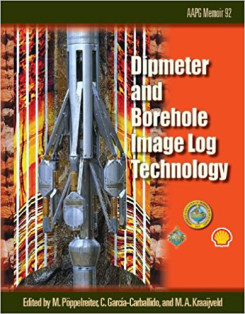Dipmeter and Borehole Image Log Technology
Borehole imaging is among the fastest and most accurate methods for collecting high resolution subsurface data. Recent breakthroughs in acquisition, tool design, and modeling software provide real-time subsurface images of incredible detail, from the drill bit straight to a workstation. Associated interpretation workflows offer the high level of detail that is needed to make operational decision and to increase the predictability of subsurface models.
Many exploration and production companies have acquired a wealth of dipmeter and image log data. The data are readily available and provide, for example the orientation of fractures and fluvial channels in space. Further applications of borehole imaging technology include matrix and fracture characterization, pore-type partitioning, geosteering, and in-situ stress determination. Exciting new applications are found in enhanced oil recovery, carbon dioxide sequestration, and geothermal projects. In addition, borehole image data are paramount to unlocking unconventional plays such as shale gas and coal-bed methane.
AAPG Memoir 92 portrays key applications of dipmeter and image log data across the exploration and production life cycle. It illustrates the value of integrating high-resolution dipmeter and borehole image data with seismic, well-log, and geological knowledge in order to construct integrated subsurface modes. It provides the fundamentals of the technology for novice and specialist geoscientists and petroleum engineers alike, as well as introducing state-of-the-art applications.
Cast & Characters
| 1-14 | Borehole Image Log Technology: Application Across the Exploration and Production Life Cycle |
| 15-38 | Borehole Image Tool Design, Value of Information, and Tool Selection |
| 39-50 | Data Management and Quality Control of Dipmeter and Borehole Image Log Data |
| 51-66 | Making Interpretable Images from Image Logs |
| 67-80 | Applications of Dipmeter and Borehole Image Data in Static Models |
| 81-112 | Geomechanical Wellbore Imaging: Key to Managing the Asset Life Cycle |
| 113-128 | Reduction of Gross Rock Volume Uncertainty in a Salt Flank Structure Using Dipmeter and Image Log Data |
| 129-144 | Applications of Oil-base Mud Earth Imager for a High-temperature and High-pressure Exploration Well |
| 145-166 | The Application of Borehole Image Logs to Fluvial Facies Interpretation |
| 167-194 | Calibrating Borehole Image and Dipmeter Logs with Outcrops and Behind-outcrop Cores: Case Studies and Applications to Deep-water Deposits |
| 195-210 | Turbidite Channel Architecture: Recognizing and Quantifying the Distribution of Channel-base Drapes Using Core and Dipmeter Data |
| 211-228 | A 3-D Fracture Model of the Kuyumba Oil Field (Eastern Siberia) Reflecting the Clay and Bed Thickness-related Fracture-density Variations of its Dolomite Reservoir |
| 229-252 | High-resolution Electrical Borehole Images While Drilling |
| 253-258 | Borehole Image Three-dimensional Visualization and Interpretation in SVS Fracture Solutions |
| 259-294 | Stress, Fracture, and Fluid-flow Analysis Using Acoustic and Electrical Image Logs in Hot Fractured Granites of the Coso Geothermal Field, California, U.S.A. |
| 295-308 | Application of a Modern Electrical Borehole Imager and a New Image Interpretation Technique to Evaluate the Porosity and Permeability in Carbonate Reservoirs: A Case History from the Permian Basin, United States |
| 309-320 | Porosity Partitioning and Permeability Quantification in Vuggy Carbonates, Permian Basin, West Texas, U.S.A. |
| 321-342 | Borehole Image and Production Logging Drives Well Interventions in Horizontal Gas-oil Gravity Drainage Wells in a Giant Middle Eastern Carbonate Field |
| 343-357 | Interpretation and Application of Borehole Image Logs in a New Generation of Reservoir Models for a Cluster of Fields in Southern Oman |

